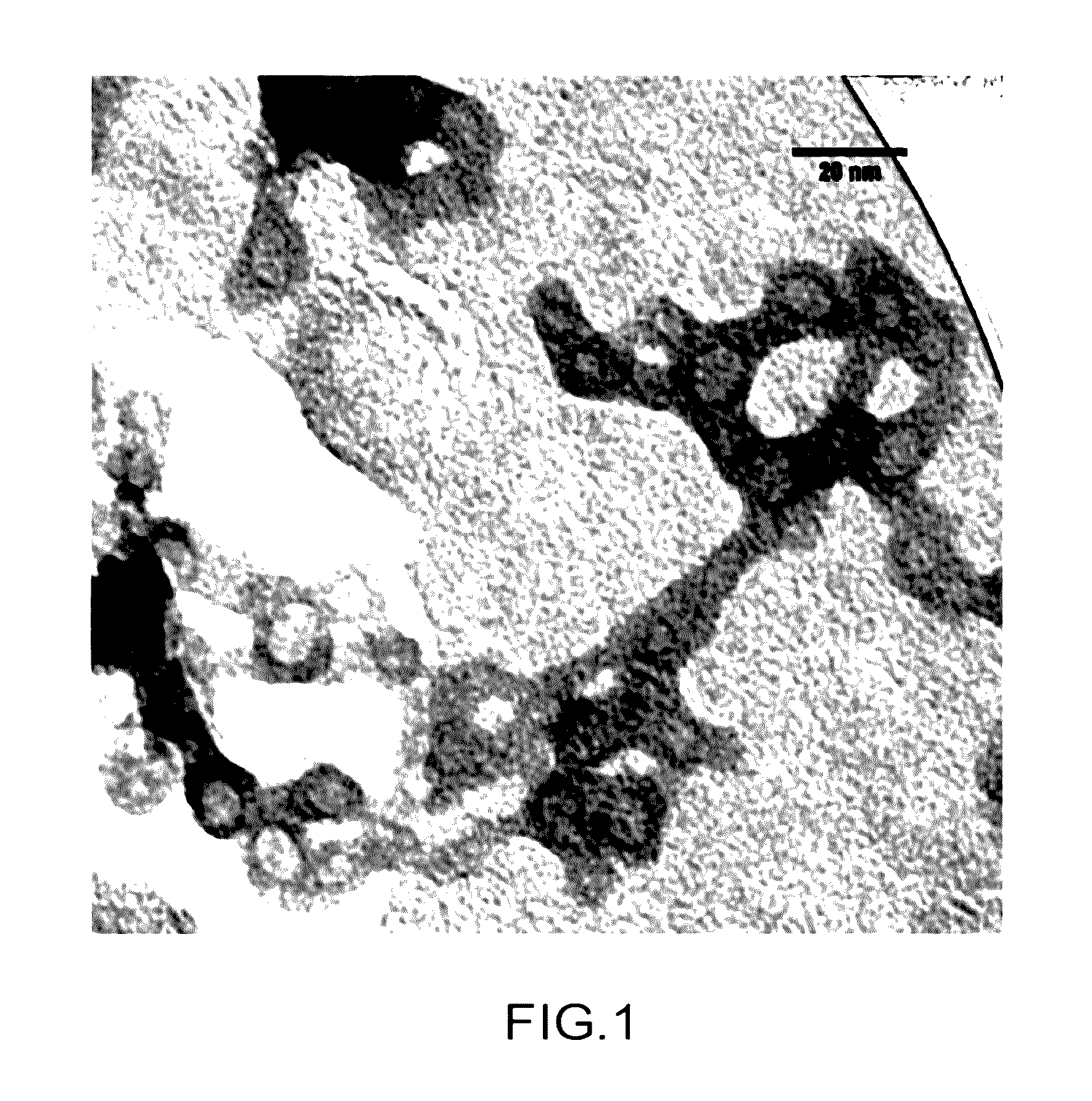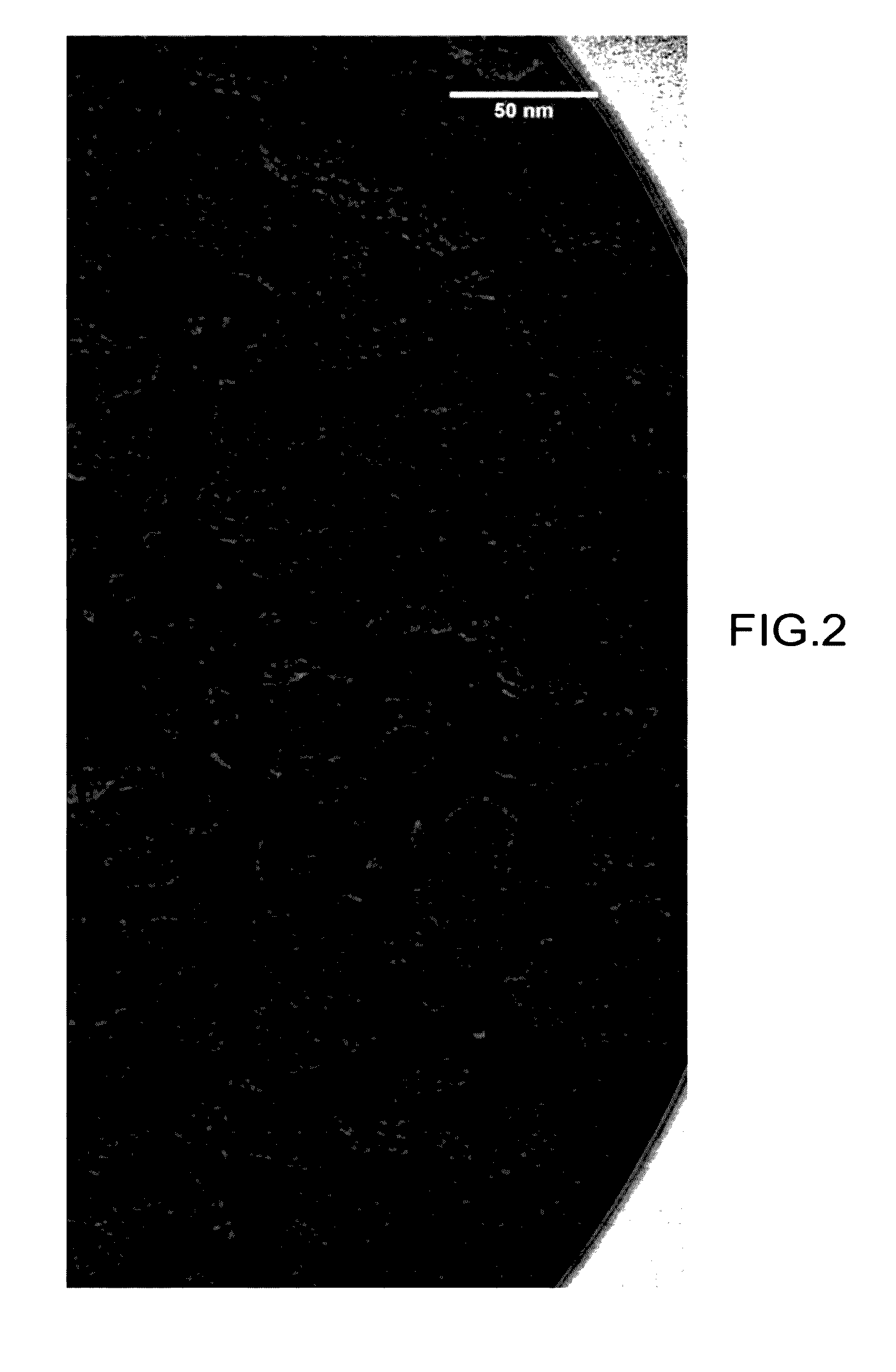Inorganic cellular monobloc cation-exchange materials, the preparation method thereof, and separation method using same
a cation-exchange material and organic cellular technology, applied in the field of cation-exchange alveolar (cellular) inorganic monolithic materials, can solve the problems of radioactive liquid effluents, inability to contemplate evaporation treatment, and inability to decontaminate industrial methods of liquid effluents, etc., to achieve excellent exchange capacity, excellent selectivity, and excellent properties
- Summary
- Abstract
- Description
- Claims
- Application Information
AI Technical Summary
Benefits of technology
Problems solved by technology
Method used
Image
Examples
example 1
[0148]In this example, the procedure for preparing silica monoliths containing ferrocyanide nanoparticles is disclosed.
[0149]The procedure for preparing silica monoliths containing ferrocyanide nanoparticles comprises the following successive steps:[0150]1. Preparation of colloidal aqueous suspensions of nanoparticles (NP) of [Kx]CuyFe(CN)6.
[0151]During this step, solutions, colloidal suspensions of nanoparticles (NP) of [Kx]CuyFe(CN)6 wherein x ranges from 0.5 to 2.5 and y ranges from 0.5 to 2 are prepared.
[0152]The concentration of nanoparticles of these solutions, suspensions may range up to 50 g / L preferably up to 32 g / L.
[0153]More specifically, two solutions, colloidal suspensions were prepared with a view to their use in the examples which follow, i.e. a suspension with 9 g / L of [K1.77]Cu1.16Fe(CN)6 and a suspension of 32 g / L of [K2.07]Cu1.08Fe(CN)6.
[0154]To this end, a solution of K4Fe(CN)6 and a solution of Cu(NO3)2 are rapidly mixed.
[0155]The respective concentrations of K4...
example 2
[0193]In this example, it is shown that it is possible to control the size of the macroporosity of silica monoliths by acting on the shear rate of the emulsion during step 6 for preparing the emulsion which precedes the step 7 for preparing the monoliths.
[0194]This preliminary study dealt with emulsions and materials not containing any nanoparticles.
[0195]The goal was to show that it was possible to synthesize silica monoliths for which the size of the macroporosity is controlled, by acting on the shear rate of the emulsion.
[0196]For this, several emulsions are prepared from a same solution E, in accordance with step 6, by achieving emulsification of this solution with a given volume of dodecane (C12H26).
[0197]The volume ratios of each constituent used for preparing the emulsion are the following: V solution P123 at 20% by weight and pH 2 / V TEOS / VNaF_8g / L / V dodecane=1.94 / 1 / 9.3.10−3 / 4.75.
[0198]In order to prepare the emulsions, a disperser-homogenizer device of the Ultraturrax® type ...
example 3
[0206]In this example, silica monoliths are prepared containing nanoparticles (NP) of ferrocyanides [Kx]CuyFe(CN)6 wherein x ranges from 0.5 to 2.5 and y ranges from 0.5 to 2.
[0207]In order to prepare these monoliths, the procedure described above is used, with concentrations of nanoparticles of the colloidal solution A (step 1 of the procedure) of 9 g / L or of 32 g / L, various volume ratios R (step 4 of the procedure) and a shear rate of 3,200 rpm during the preparation of the emulsion (step 6 of the procedure).
[0208]Table I hereafter, gives the NP concentrations of the colloidal solutions, the values of the volume ratios R, the theoretical and measured NP concentrations (by weight) of the monoliths, for the six prepared monoliths containing nanoparticles.
TABLE IName0.21@32000.43@32000.77@32001.83@32002.86@32005.1@3200Coll. Sol.9 g / l9 g / l9 g / l9 g / l32 g / l32 g / lR0.070.110.240.640.240.64Theo. wt.0.30.61.22.54.48.4% of NPs.ICP wt. %0.210.430.771.832.865.1of NPs
[0209]The weight concentrat...
PUM
| Property | Measurement | Unit |
|---|---|---|
| size | aaaaa | aaaaa |
| concentration | aaaaa | aaaaa |
| grain sizes | aaaaa | aaaaa |
Abstract
Description
Claims
Application Information
 Login to View More
Login to View More - R&D
- Intellectual Property
- Life Sciences
- Materials
- Tech Scout
- Unparalleled Data Quality
- Higher Quality Content
- 60% Fewer Hallucinations
Browse by: Latest US Patents, China's latest patents, Technical Efficacy Thesaurus, Application Domain, Technology Topic, Popular Technical Reports.
© 2025 PatSnap. All rights reserved.Legal|Privacy policy|Modern Slavery Act Transparency Statement|Sitemap|About US| Contact US: help@patsnap.com



